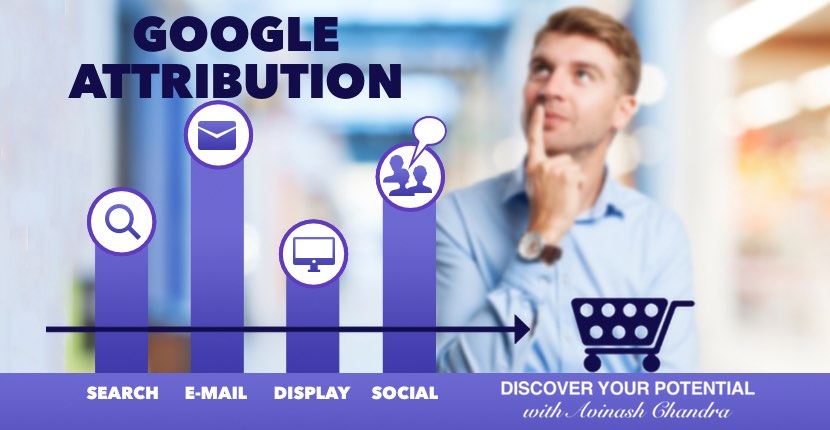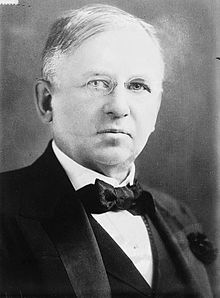
If John Wanamaker were alive today, he would have loved Google Attribution. The new attribution tool from Google would have made him happier. Do you know who John was and what is attribution meaning in marketing?
John Wanamaker was a marketing pioneer, who famously said:
“Half the money I spend on advertising is wasted; the trouble is I don’t know which half.”
The essence of what John said decades back is this:
- He Truly believed that marketing works
- However, he was not sure what is working
- How much it is contributing to his top line and bottom line
Well, This is something, which has challenged marketers for ages.
Why John would have Loved Google Attribution
The new Google Attribution tool can capture all the interactions consumer had with your brand both online and offline.
It will enable you to attribute due credit to all the touchpoints by their impact on their purchasing decisions.
Therefore, if John was around today, he could have directed all his marketing budgets towards interactions adding to his bottom line instead of guessing his marketing approach.
Google Analytics provide Attribution Data, so Why we need a new Attribution Tool
Before your customer purchases a product, he does multiple interactions with you and your competitors. Several of these interactions could be online, and several could be offline:
- Online Interactions: Organic Search, Display Ad, Search ad, Blog, Video etc.
- Offline Interactions: Store Visit, Print Advertisements, TV ad etc.
Hopefully, these interactions help her make up her mind to buy your product instead of your competition.
The impact of these interactions is not uniform and difficult to predict. Therefore, when it comes to advertising and promotions, marketers follow “SPAY & PRAY” approach. They believe that something will work and their sales will increase.
Over the years Digital marketing has been gaining popularity as it allowed marketers to find what caused an increase in their sales.
Digital marketing has been instrumental in identifying SOME of the fundamental causes of sales increase, however, primarily online only.
Digital Analytics tools such as Google Analytics, helped marketers to determine the impact of digital marketing activities to an extent.
However, most ignored that Google Analytics data is based on last click attribution. Therefore, what you knew about the entire purchase process was not a complete picture of the real world and consumer life moments.
The attribution models in Google Analytics were standardised and did not represent the real world.
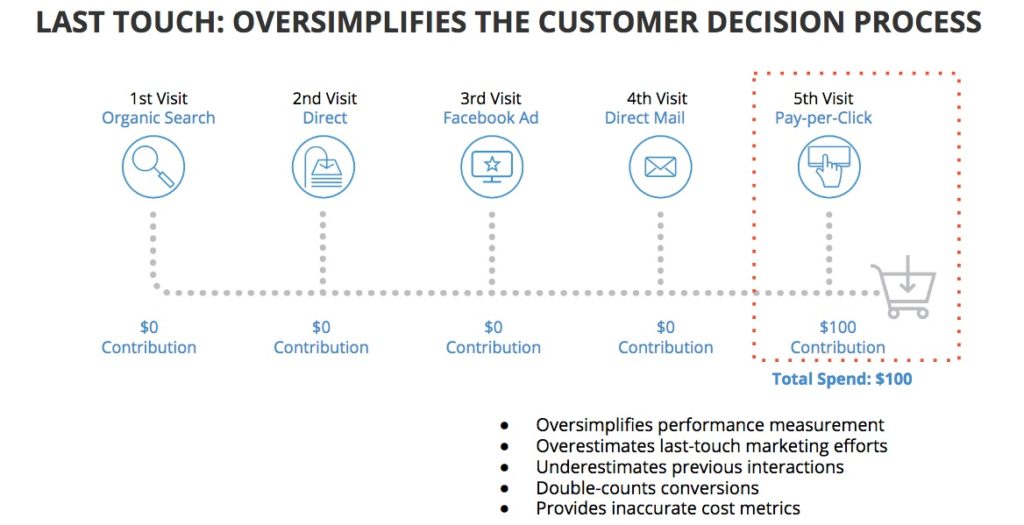
Google Attribution is the end of Last Click Attribution
Google takes its business very seriously. Therefore. now it is applying all its learnings to the new Attribution Tool that will represent the real world.
The new Google Attribution tool will bring together its:
- Thorough understanding of consumer intent
- Data and machine learning
The objective will be to make user experiences more assistive and useful than ever before.
So what does this all mean for a digital marketer?
- It will be easier and better to connect with consumers the moment they seek assistance.
- It will be easier to determine how much credit each ad and keyword gets for your conversions.
- You can reach customers earlier in the purchase cycle.
- You can find opportunities to influence customers earlier on their path to conversion.
- Use a model that works best for how people search for what you offer.
- Improve your bidding: Optimize your bids based on a better understanding of how your ads perform.
With the introduction of Google Attribution, all this is going to change for marketers of all sizes. Google Attribution is a new product to answer the question that has challenged marketers for ages.
It promises to measure the impact of a marketers efforts across devices and sales channels.
What is Attribution meaning in the context of digital marketing?
This is one question which I frequently hear from my client. Therefore to clarify let me share what essentially is the attribution meaning in a generic sense and digital marketing.
Attribution Meaning in a Generic sense
In a generic sense, attribution is the act of giving that credit where it is due. It is essentially acknowledging that something has taken place due to work of a particular person or thing.
This is crazy.
All of us are masters of attributions. Do you remember your childhood!
Well, I am not going to say anything further on that so let us move further.
Attribution meaning in Marketing
In marketing, attribution is the act of identifying and giving credit to a particular marketing activity that resulted in sales increase or helped you achieve a marketing objective.
Marketers deploy several marketing and promotion campaigns to influence the sales. Attribution helps you quantify the impact of each marketing actions on a consumers decision to buy your product.
Understanding of the causes of increase in sales helps you optimise your marketing budget as you can deploy it to activities that generate higher ROI.
Therefore attribution is something which is constantly under scrutiny. However, in traditional marketing, it was quite difficult to identify real causes of the sales increase. Therefore John Wanamaker said ” Half………”.
Meaning of Attribution in Digital Marketing
Digital Marketing primarily takes place online. As digital technology enables it to be much more insightful and accurate through attribution.
In digital marketing, attribution helps you assign credit for sales and conversions to touchpoints in conversion paths. Attribution helps you prioritise between paid & organic search, email, affiliate marketing, display ads, social media and more.
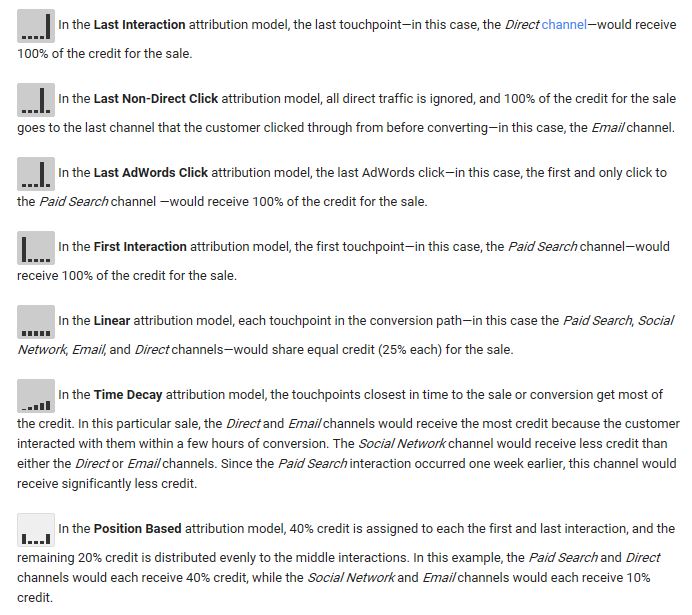
So What is Google Attribution
Google Attribution is a multichannel, multi device sales/performance measurement tool that enables a marketer to assign credit to a particular touchpoint depending on its contribution to conversion.
What it means is that Google Attribution can help you assign credit for sales and conversions to touchpoints in conversion paths.
Why Google Attribution
A customers purchase journey is quite complicated today.
Your business can have dozens of interactions with a single person – across search, social, email, display, video and on your website & retail environments. Your performance in all these consumer life moments defines the success or failure of a sales funnel.
As these interactions happen on multiple devices and channels, it is tough to measure them.
With Google Attribution, you as a marketer will be able to track a customers purchase journey and will be able to make adjustments in your sales funnel.
Google Attribution is a simplified version of Attribution 360, which is an enterprise-level offering.
What is ailing current attribution models in Google Analytics
Your business can have dozens of interactions with a single person – across search, social, email, display, video and on your website & retail environments. These interactions define your success.
Your performance in all these consumer life moments determines the success or failure of a sales funnel.
However, historically with Google Analytics tool, you have been crediting the sales to the last known interaction consumer have with your business before conversion. This practice is known as last click attribution.
Please note that last-click attribution is/was the preferred method for both Traditional marketing and digital marketing.
Last-click attribution model ignores all the touch points that precede the final touch before a purchase or conversion. Therefore this method ignores the contribution of all other individual touch-points.
Google attribution aims to simplify the multichannel, multi-device attribution.
What is so unique about Google Attribution
With this new attribution tool, Google is saying goodbye to the default last click attribution method.
Yes, with Multi-Channel funnels report and model comparison tool a marketer was able to draw some additional insights. However, that is nowhere close to what the new Google attribution tool can do.
How Google Attribution works
Google Attribution integrates seamlessly with Google Analytics, Google AdWords and DoubleClick Search without the need for any additional tagging. Once you connect these tools with Google attribution tool, it will process your marketing channels data to provide you with a complete view of your performance.
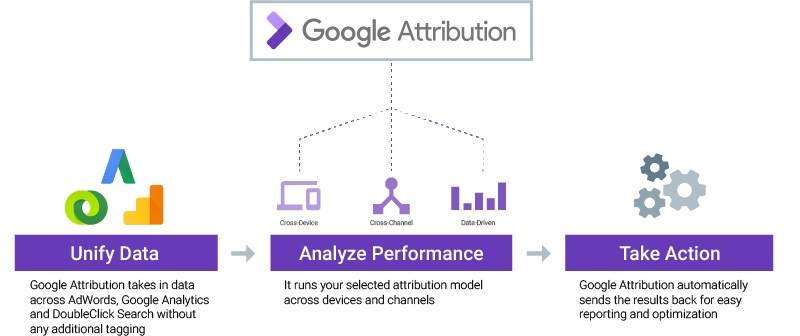
Google Attribution tool generates insights on prospective customers. It helps you understand your sales funnel and consumer behaviour.
These insights will be useful to you as a marketer to prioritise your investments. If you connect Google Attribution tool directly with your AdWords account, you can draw ideas to optimise your ad spends.
Google collects purchase or conversion data from data from Adwords, Analytics or Doubleclick. All this data along with cross-device & cross-channel info is used to analyse which touch-points have engaged the prospective consumer.
Google Attribution allows you to quickly switch to data-driven attribution to take advantage of machine learning. With data-driven attribution, you can easily assign credit to each step in the consumer journey.
This complete info is critical to understand typical user behaviour. You can compare the users who convert and those who do not.
What is unique about this attribution model
Google is trying to remove the boundaries between virtual and offline worlds. As mobiles are increasingly breaking those barriers, the insights from this attribution tool will be significant for marketers.
As a marketer now you will be able to take advantage of their advanced machine learning and mapping technology to increase and measure your sales at a physical store.
In future, the store visit measurement technology will encompass YouTube TruView campaigns, in addition to Search, Shopping and Display campaigns.
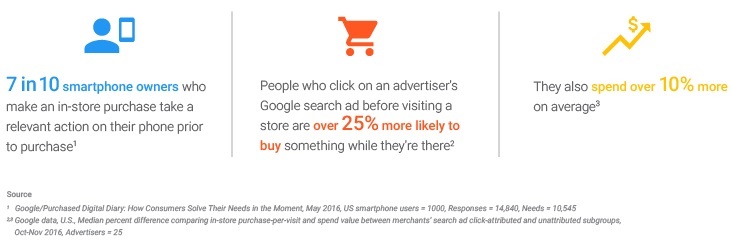
To do that Google is collecting data from credit card firms (to begin with they are tapping 70% of the credit and debit card transactions in the United States).
Benefit of Data Driven Attribution
Consumers connect with businesses much before they make a purchase. These interactions happen in multiple ways which may or may not involve:
- Organic Search
- Paid Search ad
- Display ad
- Emails
- Referral
- Affiliates
- Store visit
- and several others
With a Data-Driven Attribution credit for a conversion goes to the actual conversion driver and not the last click. Therefore Data-Driven attribution represents a real world consumer behaviour.
Key benefits of Data driven attribution
- Helps you identify and differentiate between performing and non-performing keywords, ads, ad groups, and campaigns.
- Allow you to optimise your bidding based on real consumer behavioural data for your account.
- Choose the most appropriate attribution model for your business. You do not need to depend on robotic attribution models and apply guesswork.
- A marketer can track consumer journey and decide where to deploy maximum resources to drive profitability.
So what do you think?
It will be interesting to note what you think about this development from Google.
Frequently Asked Questions
1 What can you learn from attribution reports?
Attribution reports help a marketer understand the priority of different touch points in a sales funnel. Based on the insights determined by attribution model you can optimise your marketing investments.
2 What is an attribution model in google Analytics?
In Google Analytics an attribution model is the rule or set of rules, that determines how credit for sales and conversions is assigned to touchpoints in conversion paths. For example, the Last Interaction model in Analytics assigns 100% credit to the final touch points (i.e., clicks) that immediately precede sales or conversions. In contrast, the First Interaction model maps 100% credit to touch points that initiate conversion paths.

3 What is Attribution? What is the meaning of Attribution?
In a generic sense, attribution is the act of giving that credit where it is due. It is essentially acknowledging that something has taken place due to work of a particular person or thing.
In marketing, attribution is the act of identifying and giving credit to a particular marketing activity that resulted in sales increase or helped you achieve a marketing objective.
In digital marketing, attribution helps you assign credit for sales and conversions to touchpoints in conversion paths. Attribution helps you prioritise between paid & organic search, email, affiliate marketing, display ads, social media and more.
4 What is Marketing Attribution?
In marketing, attribution is the act of identifying and giving credit to a particular marketing activity that resulted in sales increase or helped you achieve a marketing objective.
Marketers deploy several marketing and promotion campaigns to influence the sales. Attribution helps you quantify the impact of each marketing actions on a consumers decision to buy your product.
Understanding of the causes of increase in sales helps you optimise your marketing budget as you can deploy it to activities that generate higher ROI.
Therefore attribution is something which is constantly under scrutiny. However, in traditional marketing, it was quite difficult to identify real causes of the sales increase.
5 What is an Attribution Model? What is the process of Attribution?
An attribution model is the rule, or set of rules, that determines how credit for sales and conversions is assigned to touchpoints in conversion paths.
For an Example:
A customer finds your site by clicking one of your AdWords ads. She returns one week later by clicking over from a social network. That same day, she comes back a third time via one of your email campaigns, and a few hours later, she returns again directly and makes a purchase.
- In Last Interaction model icon In the Last Interaction attribution model, the last touchpoint—in this case, the Direct channel—would receive 100% of the credit for the sale.
- In the Last Non-Direct Click attribution model, all direct traffic is ignored, and 100% of the credit for the sale goes to the last channel that the customer clicked through from before converting—in this case, the Email channel.
- In the Last AdWords Click attribution model, the last AdWords click—in this case, the first and only click to the Paid Search channel —would receive 100% of the credit for the sale.
- In the First Interaction attribution model, the first touchpoint—in this case, the Paid Search channel—would receive 100% of the credit for the sale.
- In the Linear attribution model, each touchpoint in the conversion path—in this case the Paid Search, Social Network, Email, and Direct channels—would share equal credit (25% each) for the sale.
- In the Time Decay attribution model, the touchpoints closest in time to the sale or conversion get most of the credit. In this particular sale, the Direct and Email channels would receive the most credit because the customer interacted with them within a few hours of conversion. The Social Network channel would receive less credit than either the Direct or Email channels. Since the Paid Search interaction occurred one week earlier, this channel would receive significantly less credit.
- In the Position Based attribution model, 40% credit is assigned to each the first and last interaction, and the remaining 20% credit is distributed evenly to the middle interactions. In this example, the Paid Search and Direct channels would each receive 40% credit, while the Social Network and Email channels would each receive 10% credit.

